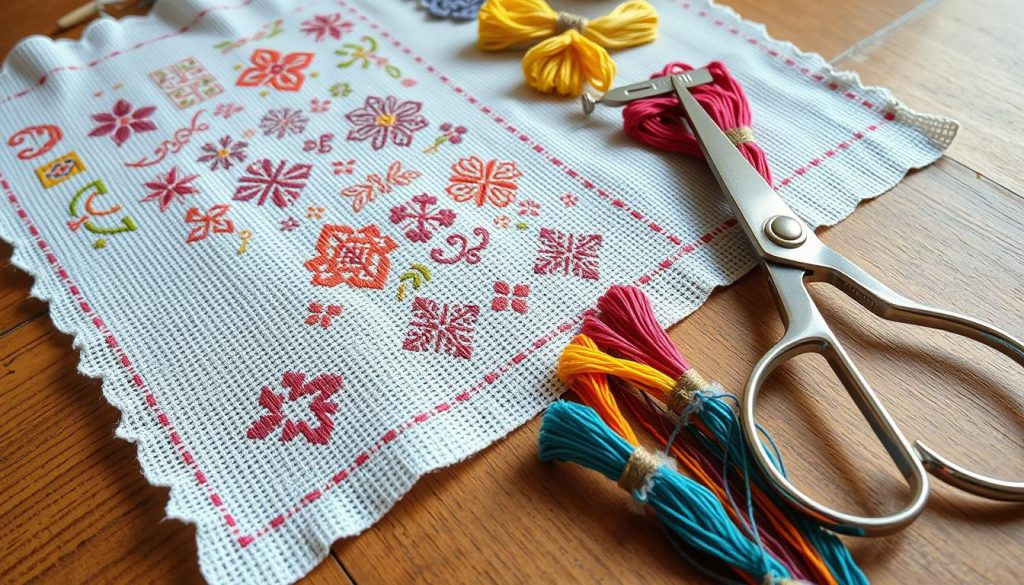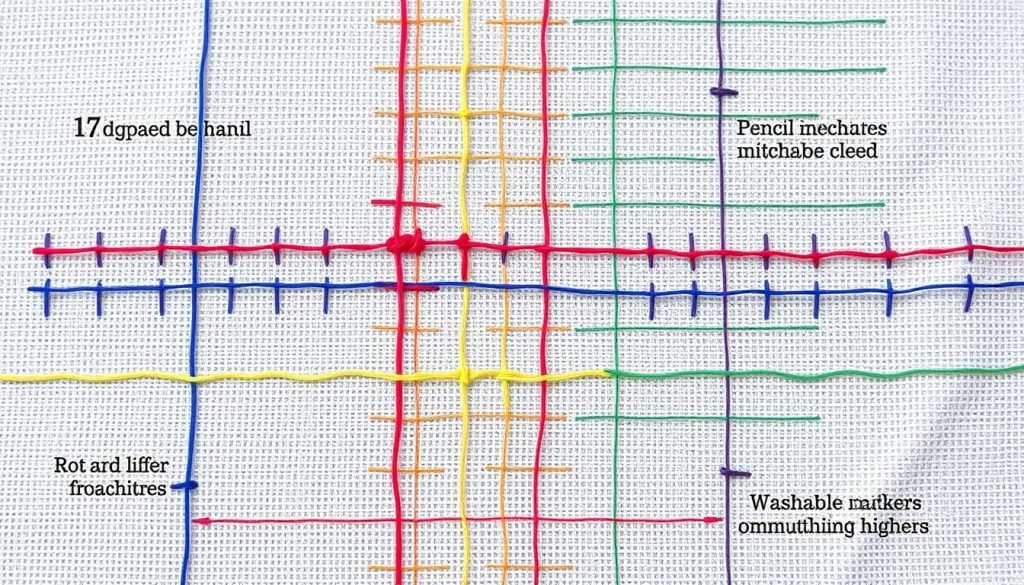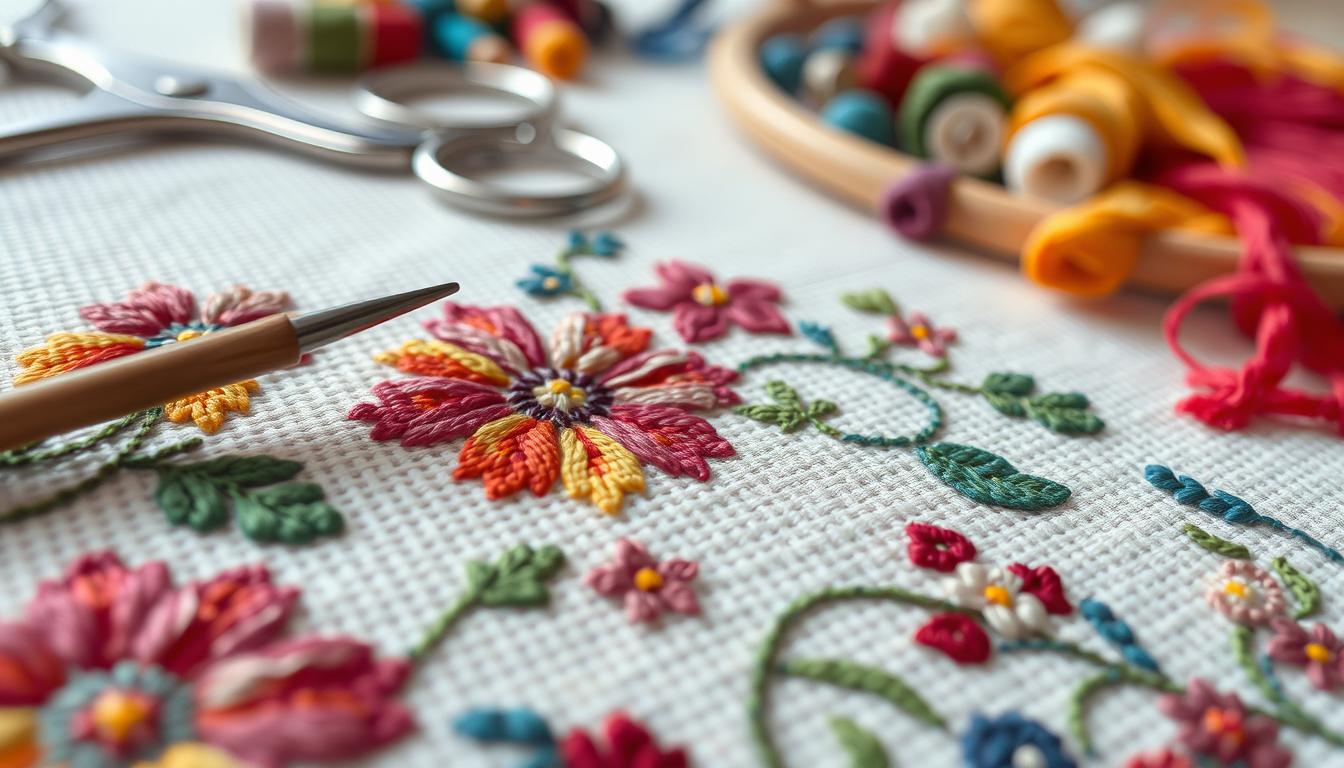If you love cross stitch, especially big or detailed designs, you might wonder about gridding. Gridding means drawing lines on your fabric in 10×10 squares to guide you. It’s great for both new and experienced stitchers, helping you place stitches right and avoid mistakes.
Gridding is super useful for complex patterns. It keeps you on track and saves you from the hassle of fixing errors. You can grid your fabric with embroidery threads, washable pens, or even special fabrics like Magic Guide by DMC, which you can wash away.
Learning about gridding through cross stitch tutorials can help a lot. It doesn’t matter if you’re just starting or have been stitching for years. Gridding adds structure and clarity, making big or detailed designs easier to handle.
Key Takeaways
- Gridding involves marking 10×10 stitch squares on your fabric.
- It helps prevent miscounting and ensures your design fits the canvas.
- Multiple materials, such as embroidery threads and washable pens, can be used for gridding.
- For large projects, pre-gridded fabrics like Magic Guide by DMC offer convenience.
- Gridding is especially useful for intricate and large cross stitch designs.
Understanding the Concept of Gridding
Gridding is a key step in cross stitch. It involves drawing a grid on the fabric that matches the pattern’s 10×10 blocks. This grid helps stitchers by making it easier to count threads.
Most charts have thick lines every 10 stitches. These lines help place stitches accurately. They also ensure the design is centered on the fabric.
Gridding is great for stitching multiple patterns on one fabric. It keeps designs aligned and evenly spaced. It’s also useful for the “cross country” method, where you count squares instead of stitches.
Gridding also helps track your progress. It’s useful for full coverage designs. You can see how much you’ve done and how much is left.
Many materials can be used for gridding, like embroidery threads or washable pens. Some fabrics, like Zweigart Easy Count, come pre-gridded. Others, like FriXion markers, can be erased with heat.
Reasons to Grid Your Cross Stitch
Gridding your cross stitch project can make a big difference. It offers benefits for both new and experienced stitchers. Let’s look at why you should try it.
Improves Counting Accuracy
One key cross stitch tip is to break down patterns into smaller parts. Gridding helps you count more accurately. It makes following complex designs easier. Each square in the grid helps you stay on track.
Ensures Cross Stitch Project Fits Your Canvas
Gridding helps your project fit the canvas perfectly. This is crucial for big, detailed designs. For smaller projects, water erasable pens are a great, affordable way to grid.
Helps Align Multiple Cross Stitch Patterns
Gridding is great for projects with many patterns. It makes aligning them easier. This is especially helpful for intricate designs where precision is essential.
Facilitates Cross Country Stitching
The cross country stitching method involves stitching one color at a time. Gridding helps keep track of where you are. This reduces mistakes and keeps your stitches even.
Tracks Cross Stitching Progress Easily
Gridding also makes tracking your progress simple. You can see which parts are done and which need work. This makes stitching more fun and less stressful.

| Method | Type of Project | Cost | Time Required |
|---|---|---|---|
| Water Erasable Pen | Small, short-term | Lower initial cost | Fast |
| Easy Count Guideline Wire | Large, long-term | Higher initial cost | Approx. 30 min for 5×8 strip on 14ct aida |
Using these cross stitch techniques can improve your projects. It makes the process smoother and your work better. Whether you’re new or experienced, gridding is a big help.
Material Options for Gridding
Choosing the right material for gridding your cross stitch fabric is key. There are many options, each suited for different projects and tastes. Knowing these can help you pick the perfect cross stitch supplies for your project.
Thread-Based Gridding
You can use embroidery threads, sewing threads, or specialized threads like Easy Count Guideline for gridding. Embroidery or sewing thread works well on linen and evenweave fabrics. These fabrics can be hard to draw on.
Easy Count Guideline, a red nylon thread, is made for needlework. It’s durable and easy to see, even in long projects.
Fishing line, especially the 8-pound test dark blue, is also a good choice. It’s strong and can be reused. But, use a fine sewing needle to avoid making holes too big in your fabric.
Marker-Based Gridding
Water-soluble fabric markers are another option. They let you draw lines directly on the fabric, like your pattern’s gridlines. But, be careful because they can stain the fabric if not washed out right away.
For a quick fix, you can buy pre-gridded cross stitch fabric. This cross stitch supplies has 10×10 squares already marked. It saves time and helps avoid mistakes in your stitch count.
| Material | Pros | Cons |
|---|---|---|
| Embroidery Thread | Easy to find, good visibility | May tangle |
| Easy Count Guideline | Durable, designed for needlework | Can be more expensive |
| Fishing Line | Strong, reusable, less likely to tangle | Requires fine needle to avoid widening holes |
| Water-Soluble Pen | Easy to use, clear lines | May leave permanent marks if not washed promptly |
| Pre-Gridded Fabric | Saves time, reduces errors | Limited color options |
Different Cross Stitch Techniques to Grid Aida Fabric
Gridding your Aida fabric can make cross stitching more fun and accurate. There are many ways to do it, each with its own benefits. You can pick the method that works best for you, using different tools and accessories.

Using Single Strand of Embroidery Thread
Using a single strand of embroidery thread is simple and cost-effective. You make small stitches every 10 holes to draw the grid lines. ‘Easy Count Guideline’ is a good choice because it’s easy to remove later.
This method is great for those who like to do things by hand. It keeps your workspace tidy and makes managing the thread easy.
Utilizing Washable Pens and Rulers
Washable pens and rulers are a flexible way to grid your fabric. Draw lines every 11th hole until you’ve covered the whole fabric. Make sure to test the pen on a small piece of fabric first.
Water-soluble fabric pens are popular for cross stitch. They let you make changes easily and are a must-have accessory.
Advantages of Blending Filament and Fishing Line
Using filament and fishing line is a durable way to grid your fabric. They stand out and are less likely to get stitched over. Fishing line is especially good because it doesn’t tangle easily.
These tools are perfect for detailed designs or big projects. They make gridding easier and help you achieve precision.
Ease of Using Pre-Gridded Cross Stitch Fabric
Pre-gridded Aida fabric is a convenient option. It’s marked with grid lines that wash out after stitching. While it costs a bit more, it saves time and reduces mistakes.
It’s great for both beginners and experienced stitchers. It makes your cross stitch project smoother and less stressful.
Gridding your fabric well helps avoid mistakes and makes stitching more enjoyable. The right tools and accessories ensure your work looks even and well-done. This makes your creative time more rewarding.
Common Challenges and Solutions
In cross stitch, fans often hit a few bumps. But, with smart strategies, these hurdles can be overcome. We’ll look at three main issues: dealing with fabric marker marks, centering and measuring fabric, and picking the best gridding method.
Dealing with Cross Stitch Fabric Marker Residue
When gridding your fabric, marker residue is a big worry. Use markers that can be erased with heat or water to avoid stains. After finishing, wash the fabric to get rid of any ink left behind. Also, using heat can help remove any remaining marks from your work.
Centering and Calculating Fabric Dimensions
Getting your fabric dimensions right is key for a centered design. Use fabric calculators and plan carefully to ensure a perfect fit. Knowing the threads per inch helps you plan better and avoid surprises.
Choosing the Right Gridding Method for Your Project
The right gridding method depends on your project’s complexity, fabric, and your style. Markers, pre-gridded fabric, or embroidery thread are all options. Think about your project’s needs before choosing to match it best.
| Challenge | Solution |
|---|---|
| Fabric Marker Residue | Use heat-erasable or water-soluble markers and wash fabric after completion. |
| Calculating Fabric Dimensions | Use fabric calculators and plan based on thread count per inch. |
| Choosing Gridding Method | Select based on project complexity, fabric type, and personal preference. |
By tackling these common issues with smart solutions, your cross stitch journey will be smoother. Good planning and execution of finishing techniques, along with proper storage and floss organization, lead to a beautiful final piece.
Conclusion
Gridding your cross stitch projects makes stitching easier and less prone to mistakes. It helps you finish complex designs faster. You can pick the right gridding method based on your project’s needs.
Using embroidery thread or pre-gridded fabric each has its own benefits. They can make your work flow better and more accurate. This makes your stitching experience better.
Techniques like using washable pens and rulers are key to success. They help you stitch accurately. Also, blending filament and fishing lines are great for complex patterns.
These methods work best when they match your project and your style. There’s no single way to do cross stitch that fits everyone.
Joining cross stitch communities is very helpful. You can find lots of advice and tips online. They help with problems like fabric marker marks or figuring out fabric sizes.
These communities also share free patterns. This helps everyone grow creatively and builds a strong community spirit.
Gridding your project carefully keeps your stitches even and in line. It’s good for both new and experienced stitchers. The tips from communities make stitching more enjoyable and rewarding.
With affordable materials and tools, cross stitching is a fun and accessible craft. It’s a great hobby for anyone to enjoy.
